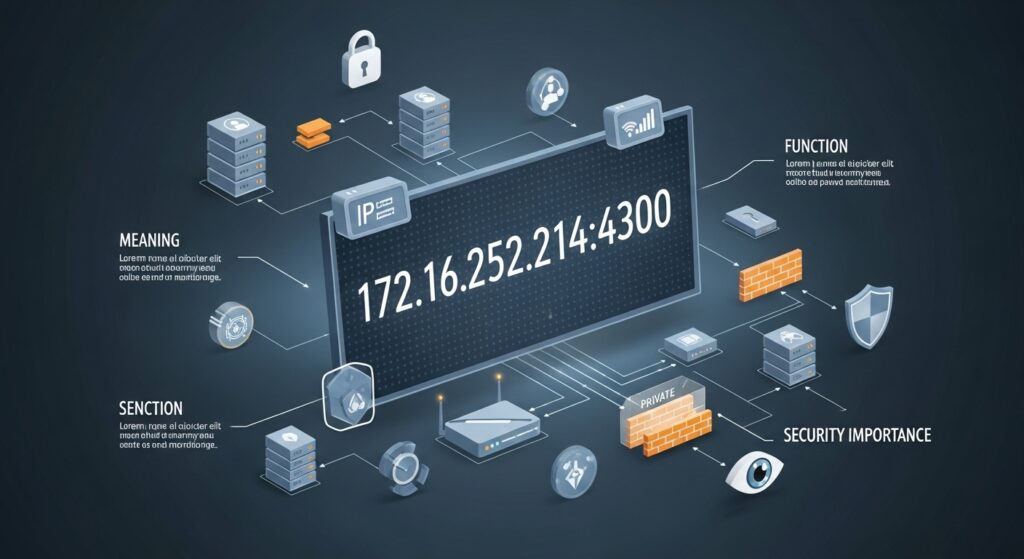The keyword 172.16.252.214:4300 often appears in network configurations, testing environments, or local connection settings. While it may look like a random IP address, 172.16.252.214:4300 has a deeper significance in computer networking. It represents a private IP within a controlled range, typically used for internal communication between systems, devices, or servers. Understanding how 172.16.252.214:4300 functions can help administrators, developers, and cybersecurity experts manage their networks more efficiently.
Breaking Down 172.16.252.214:4300
To fully understand 172.16.252.214:4300, it’s essential to separate its components. The “172.16.252.214” is the IP address, while “4300” represents the port number. This combination forms a specific communication endpoint used in networking. In local or enterprise setups, 172.16.252.214:4300 might link devices or applications that exchange data securely without exposure to the public internet. The IP belongs to the 172.16.0.0 to 172.31.255.255 private range, which means 172.16.252.214:4300 cannot be accessed directly from external networks.
Why 172.16.252.214:4300 Is Used in Private Networks
Private IP addresses like 172.16.252.214:4300 serve as the backbone for secure and efficient local communication. They allow companies to create isolated network environments where servers, databases, and software systems interact seamlessly. For example, a developer might use 172.16.252.214:4300 to connect a testing server with an application running in a development sandbox. This prevents data leaks, unauthorized access, and external interference. Using 172.16.252.214:4300 also reduces dependency on public IPs, optimizing internal routing and resource management.
How 172.16.252.214:4300 Works in a Network Environment
When a device communicates using 172.16.252.214:4300, the port number “4300” plays a vital role. It specifies the exact channel where the data packets should be sent or received. Think of 172.16.252.214:4300 as a virtual mailbox within a larger system—data arrives through that specific address and port combination. System administrators often configure services or applications to listen on 172.16.252.214:4300 to ensure precise and secure data flow. By doing this, they can control which services respond to internal network requests.
Security Aspects of 172.16.252.214:4300
One major benefit of using 172.16.252.214:4300 is enhanced security. Because it exists within a private range, external users cannot access it directly. This adds a layer of protection against cyberattacks and unauthorized scanning attempts. However, misconfigurations or open ports can still create internal vulnerabilities. Administrators should implement firewall rules, intrusion detection systems, and strict authentication policies to safeguard services running on 172.16.252.214:4300. Regular monitoring ensures that the address remains secure and doesn’t expose sensitive systems to risk.
Common Uses of 172.16.252.214:4300 in Development
In software testing, 172.16.252.214:4300 is often used to simulate real network conditions. Developers might run a database server on 172.16.252.214:4300 to test how an application interacts with local data. Similarly, network engineers use 172.16.252.214:4300 to analyze internal traffic or test new configurations without affecting production systems. These controlled environments help teams detect bugs, optimize performance, and ensure reliability before rolling updates to live servers. By using 172.16.252.214:4300, professionals gain a safe space for experimentation and troubleshooting.
Troubleshooting Issues Related to 172.16.252.214:4300
When 172.16.252.214:4300 fails to respond, it may indicate a configuration issue, firewall block, or inactive service. To troubleshoot, check whether the device assigned to 172.16.252.214:4300 is reachable via ping or network diagnostics. Confirm that the port 4300 is open and that the associated service is running. In complex environments, DNS mismatches or proxy restrictions may also cause connectivity failures. Properly maintaining 172.16.252.214:4300 ensures stability and uninterrupted communication across internal networks.
The Importance of Managing Private IPs Like 172.16.252.214:4300
Efficient management of private IP addresses, including 172.16.252.214:4300, is crucial for network scalability. Poorly organized IP allocation can lead to conflicts, downtime, and security breaches. Implementing documentation, subnet planning, and access controls around 172.16.252.214:4300 helps maintain a clean and safe infrastructure. With structured management, businesses can optimize their internal systems, improve performance, and ensure long-term reliability.
Conclusion
In conclusion, 172.16.252.214:4300 represents more than just numbers—it’s a key component of private networking. It ensures secure internal communication, supports software testing, and helps businesses protect critical data. When used properly, 172.16.252.214:4300 enhances both performance and security across digital environments. Understanding and managing it effectively allows IT professionals to build strong, resilient, and efficient network systems that can adapt to future challenges.
